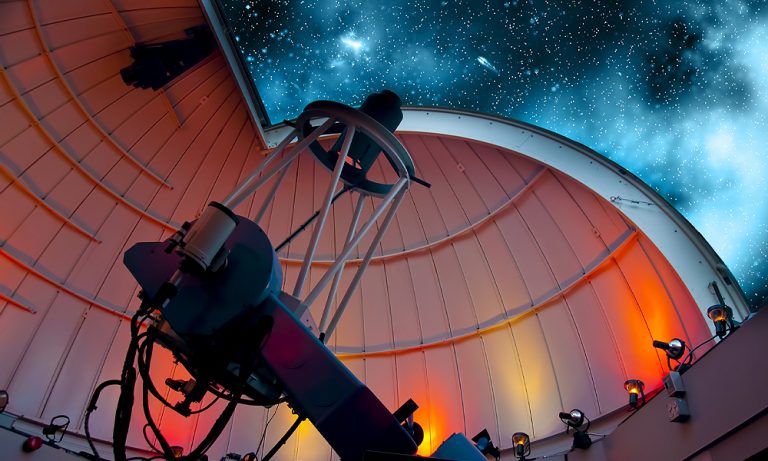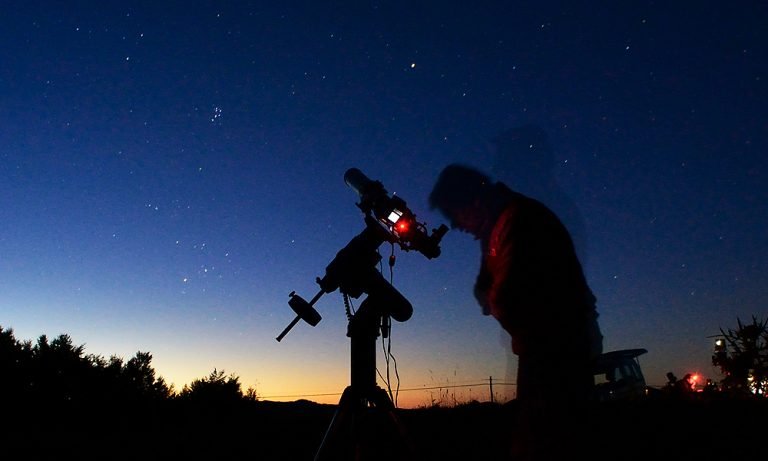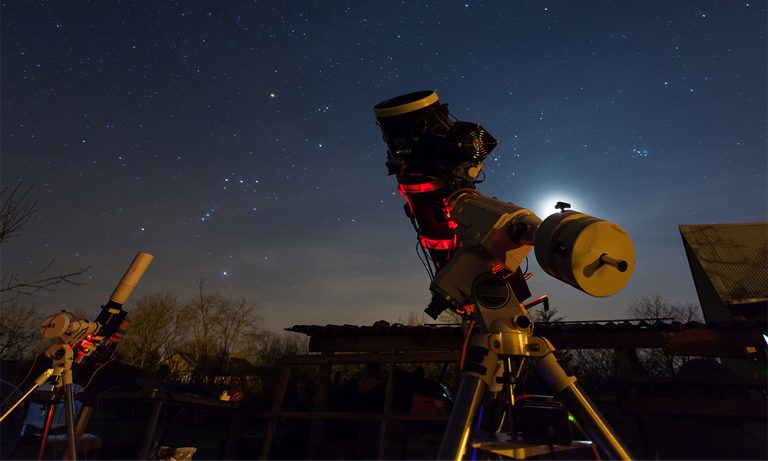12 Best Refractor Telescopes Actually Worth the Money [2024]
Refractor telescopes are great for astronomy and terrestrial viewing, but they especially shine in astrophotography.
That’s because they offer the clearest images (compared to reflectors) and are practically zero-maintenance.
The best refractor telescope is free of chromatic aberration (apochromatic), and comes with a large aperture and buttery smooth focuser.
Best Refractor Telescope
1. Orion AstroView 102mm Equatorial Refractor Telescope
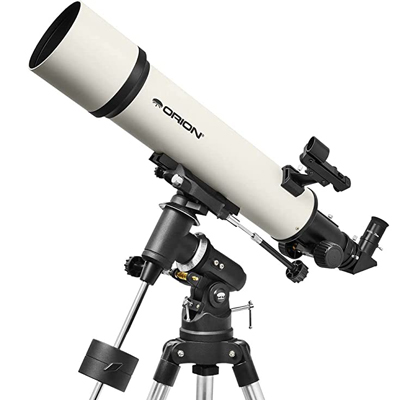
The Orion AstroView 102mm refractor telescope is a perfect beginner telescope offering the most value for money.
You can easily enjoy star clusters, nebular clouds, and planets with the sharp 4 inch lens and the kit comes with two essential eyepieces for 28x and 70x magnification.
This Orion refractor is highly portable and has a low-maintenance design, making it the best refractor telescope for beginners.
The biggest benefit is that it’s also properly aligned out of the box and never have to be adjusted by the user. This is especially handy, compared to a reflector, which requires periodic collimation by the user.
The best refracting telescope comes with an equatorial mount that offers smooth tracking, whether utilized manually with the slow-motion control cables (included) or with an optional electronic drive for hands-free tracking.
This refractor kit offers the best value for money, you get everything you need to start observing and you won’t grow out of it even you are an intermediate-level stargazer.
What We Liked
- Ideal for new to intermediate-level stargazers
- Comes with an all-in-one kit
- Zero effort low-maintenance design
- Extremely sharp optics for the price
- Sturdy equatorial mount offers smooth tracking
What Can Be Improved
- Many cheaper refractors suffer chromatic aberration (not an argument for beginners)
- Not that ideal for astrophotography
Aperture: 4″ (102mm)
Magnification: 14-201x
Focal length: 700mm
Mount type: Equatorial
Weight: 23.5 lbs.
Best for: Beginners, lunar & planetary viewing
2. Orion EON 110mm ED f/6.0 Apochromatic Refractor Telescope

The Orion EON 110mm apochromatic refractor telescope is the best refractor telescope for astrophotography.
This apochromatic refractor comes with a long focal length (f/6) that offers perfect color correction for wide-field astrophotographic images.
I haven’t seen a chromatic aberration on any object I have imaged and the dual-speed hybrid-drive focuser is buttery smooth.
The focuser can be rotated in 2 places, which allows the camera framing to be set independently from your preferred positioning of the apochromatic refractor telescope’s focus knobs.
For an astrophotography refractor, it’s surprisingly compact (just under 22’’), and the sliding dew shield can be retracted for easy transport.
Unlike other bulkier astrophotography telescopes, the EON needs only a medium-sized mount to support It (e.g. Orion Sirius EQ-G).
In the astrophotography world, this refractor offers a lot of value for the money.
What We Liked
- Apochromatic refractor, meaning no chromatic abbreviation
- Best value for money astrophotography refractor
- Built like a tank – you can mount up to 17lbs worth of equipment on top of it
- Physically lightweight and has a quick cool down
- Buttery smooth focuser
- Offers a wide field of view and sharpness
What Can Be Improved
- Doesn’t come with a dovetail
Aperture: 4.3″ (110mm)
Magnification: 16-220x
Focal length: 660mm
Mount type: Equatorial
Weight: 11.5 lbs (optical tube)
Best for: Deep-sky imaging, wide-field observing
3. Celestron Advanced VX 6 inch Refractor Telescope
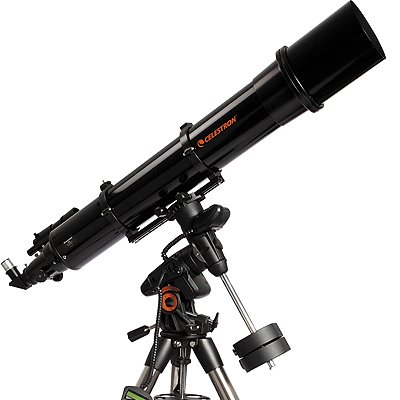
The Celestron VX6 was a more expensive 6 inch refractor telescope that we reviewed, and the quality certainly wowed us.
It has a 6″ (150mm) aperture and a 1200mm focal length. It comes with an Advanced VX GoTo mount and a tripod loaded with features and techno utilities.
The mount has integer gear ratios and permanently programmable Periodic Error Correction. This state-of-the-art feature helped us to eliminate recurring tracking errors and optimized imaging.
The mount features significantly larger base castings, which improve stability. It was very sturdy and we had no concerns about the scope toppling over, even when our enthusiastic kids wanted to take a look at the sky.
This largest refracting telescope is designed for advanced stargazers. We were amazed at the crystal clear images of the moon, planets, far-away galaxies, star clusters, and deep sky objects.
We also tried our skills at astrophotography and produced very exciting images.
The telescope comes with a built-in auto guider port, a 9×50 finder scope, and a 20mm 1.25″ telescope eyepiece. It is large and heavy and is not suitable for transporting.
To do this refractor telescope review, we set it up at home in a safe place for all our viewing.
What We Liked
- Best refractor telescope for the money
- 6″ (150mm) aperture
- Advanced VX GoTo mount
- Built-in autoguider port
- Larger base castings improve stability
- Exceptional images of near and far celestial objects
- Ideal for astrophotography
What Can Be Improved
- High price
- Not for beginners
- Heavy and stands tall, cannot be easily transported
Aperture: 6″ (150mm)
Magnification: 60x
Focal length: 1200mm
Mount type: Advanced VX GoTo mount
Weight: 71 lbs (32kg)
Features: Stable GoTo mount loaded with features
Best for: Advanced intermediates
4. Sky Watcher Evostar 80ED APO Refractor Telescope
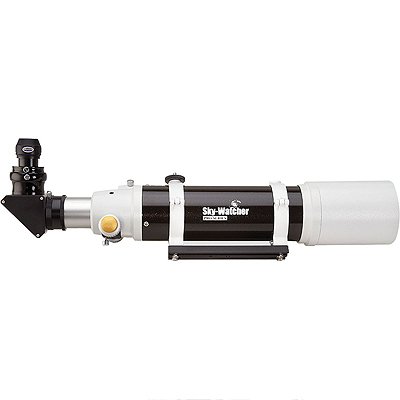
If you are looking to invest in an apochromatic telescope that will take you from beginner status to professional, the Sky Watcher Evostar 80 APO Telescope is a perfect choice.
Start as a novice and move on to becoming a seasoned astrophotographer as your skill set improves. In this case, paying a higher price does offer exceptional quality.
The optics feature metallic high-transmission refracted lens coatings, which virtually eliminates residual chromatic aberration. We saw amazing views of planets, star clusters, far-way galaxies, and nebula.
The color definition on this apo refractor is exceptional, created by Metallic High-Transmission Coatings. The images also have minimal aberrations.
The scope comes with a foam-lined aluminum hard case for safe packing and transporting. Weighing in at 22 lbs, it is easy to load into a car for a weekend away.
Note that this refractor scope does not come with a mount, so you will need to use an existing one or purchase one.
It features an 80mm aperture and comes with two LET eyepieces, a 5mm, and a 25mm. Also included is an 8×50 Right Angle Correct Image Finderscope, Mounting Rings, and a V-Style Dovetail.
There are 2-speed focuser knobs and a camera adapter that allowed us to try out some astrophotography.
What We Liked
- 3.1” (80mm) aperture for bright views
- Ideal for beginners and more experienced stargazers
- Best apochromatic refractor with high-quality optics
- Metallic High-Transmission Coatings for exceptional color
- 10:1 dual-speed Crayford-style focuser
- Almost no aberration
- Great for astrophotography
What Can Be Improved
- Higher price
- Need to purchase your own mount
- The lens cap doesn’t fit well
Aperture: 3.1″ (80mm)
Magnification: 30-120x
Focal length: 600mm
Mount type: Not included
Weight: 22 lbs (9.97kg)
Features: High-quality glass optics, 10:1 dual-speed focuser
Best for: Great for beginners advancing to Intermediate
5. Celestron Omni XLT 120 mm Refractor Telescope
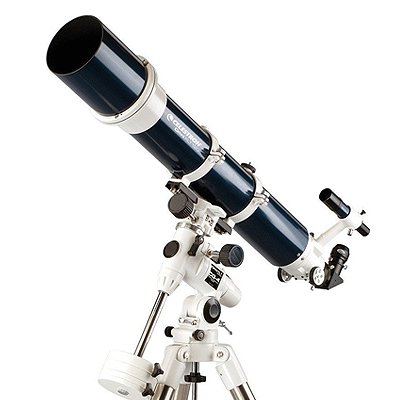
This Celestron 120mm refractor telescope received some of the best ratings and we were eager to try it out.
It features quality optics that are hand selected and made only of the finest grade optical glass.
The 120mm lens gave us stunning views of the moon, planets, nebula, and star clusters.
It comes with a 25mm multi-coated eyepiece that has a 20mm eye relief, ideal for people who need to keep their eyeglasses on when observing.
The images are crystal clear with almost no spherical aberration. This is achieved by using Aspheric Shaping Technology in conjunction with hand-figuring the optics. It also offers the StarBright XLT coating system to further enhance light transmission.
The mount is a very stable German Equatorial CG-4 mount that was easy to set up without needing tools. It has slow-motion controls that keep the object smoothly lined up for viewing. Weighing in at 46lbs, it is rather heavy.
This telescope is best suited to setting up in a permanent place in your home. It comes with a very helpful Sky Level 1 planetarium software with 10,000 object database and enhanced images.
What We Liked
- 4.7″ (120mm) aperture for bright views
- 25mm multi-coated eyepiece with 20mm eye relief,
- Sturdy German Equatorial CG-4 mount
- Slow-motion controls for easy viewing
- Aspheric Shaping Technology
- Clear images with almost no spherical aberration
What Can Be Improved
- Higher price
- Not motorized
- Heavy to move around
Aperture: 4.7″ (120mm)
Magnification: 17-283x
Focal length: 1000mm
Mount type: Omni CG-4 Equatorial
Weight: 46 lb (20.87 kg)
Features: Quality images with Aspheric Shaping Technology
Best for: Intermediate stargazer
6. Explore Scientific FirstLight AR127mm Refractor Telescope
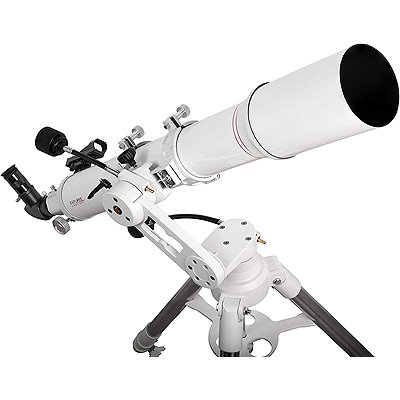
The Explore Scientific 127mm Refractor offers great value for the price.
If your budget is a little higher and want something of great quality, this is a good telescope to try.
It has a higher focal ratio of f/9.4, making it perfect for observing single objects such as planets or stars (you’ll be able to see Jupiter clearly and the bands of Jupiter’s rings).
Despite not being apochromatic, this telescope manages to provide crisp images with minimal chromatic aberration. On the downside, its red-dot finder is reportedly mediocre quality.
It comes with a Twilight 1 alt/AZ mount, 2.5-inch focuser, two eyepieces, and a red-dot finder.
What We Liked
- Crisp and unobstructed views of planets and stars
- Little chromatic aberration despite not being apochromatic
- Lightweight
What Can Be Improved
- Included red-dot finder is mediocre quality
Aperture: 127mm
Focal Ratio: f/9.4
Weight: 21 lb
7. Explore Scientific FirstLight AR102 EXOS Refractor Telescope
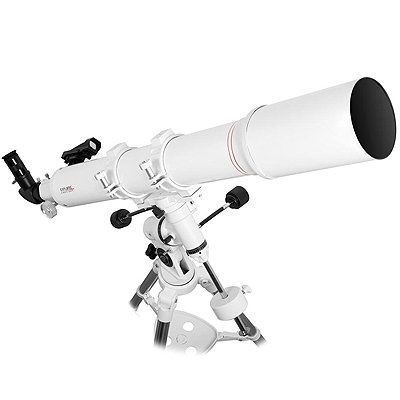
The Explore Scientific FirstLight is a top refractor telescope and comes with a high quality glass 4” aperture with a 25mm Plossl eyepiece.
It has a focal length of 1000mm. It comes with a Red Dot Finder, Smart Phone Camera Adapter, a 2.5″ Hexagonal Focuser, and a sturdy balancing counterweight on the mount.
This was our first experience with a quality GoTo Computerized EQ Mount and I did rely on my tech-savvy teens to help get it going.
Unlike hand-controlled mounts, a GoTo Mount will automatically track your celestial object as it moves across the sky, by making use of mobile smartphone technology.
We found the Explore Scientific FirstLight AR102 EXOS Refractor Telescope easy to use and were amazed at the fabulous views we got of the moon, planets, star clusters, and deep-sky objects.
As a good refractor telescope, it is priced high and is more suitable for experienced stargazers.
What We Liked
- 4″ (102mm) aperture for bright views
- 1 eyepiece – 25mm Plossl
- Quality GoTo Computerized EQ Mount
- Red Dot Finder
- 2.5″ Hexagonal Focuser
- Smart Phone Camera Adapter
- GoTo System database with over 272,000 astronomical objects
What Can Be Improved
- Computer App may not suit all users
- Carry case must be purchased separately
Aperture: 4″ (102mm)
Magnification: 175x
Focal length: 1000mm
Mount type: EXOS Nano EQ3 German Equatorial mount
Weight: 29 lb ( 13.1 kg)
Features: GoTo Computerized Mount, Red Dot Finder
Best for: Intermediate stargazers
8. Celestron AstroMaster 90EQ Refractor Telescope
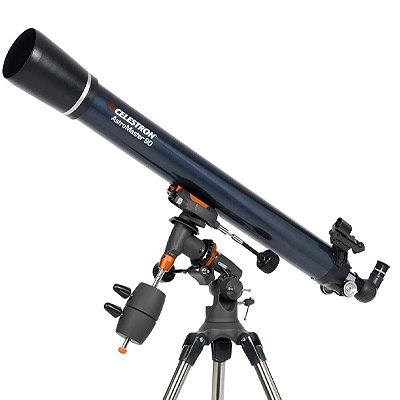
The Celestron AstroMaster 90EQ Refractor is a great telescope for beginner astronomers.
The best part is the low price point for those on a budget.
However, while it is cheap and great for learning the ropes, the optics on this telescope aren’t the greatest.
You’ll be able to see the moon pretty well, but you won’t be able to see any deep-space objects or even some distant planets clearly.
What We Liked
- Excellent telescope for beginner astronomers
- Great price
- Two-year warranty
- Lightweight, easy for mobile use
What Can Be Improved
- Not apochromatic
- Limited viewing range
Aperture: 90mm
Focal Ratio: f/11
Weight: 27 lb
9. Messier R-102 102/1000 OTA Achromatic Refractor
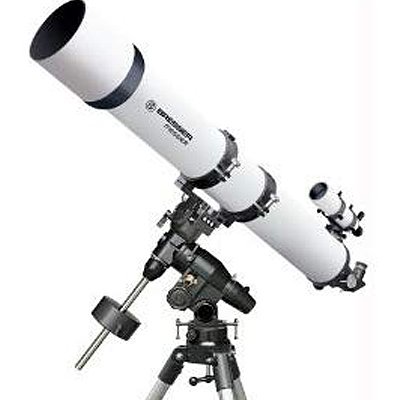
The Messier R-102 OTA Achromatic Refractor is the most expensive telescope on this list.
Though it claims it’s for both beginners and advanced users, this telescope definitely works best for advanced amateur astronomers.
Its high-quality optics provide precise observation of both planets and stars, at distances up to 1,500 lightyears away.
The focal ratio of 9.8 makes this telescope great for astrophotography.
However, the telescope’s relatively small aperture doesn’t excel at observing deep-sky objects. It’s also achromatic, which means it only focuses two light wavelengths compared to the three that apochromatic provides.
It comes with an equatorial mount, focuser, finderscope, camera adapter, and astronomy software, Stellarium.
What We Liked
- Great for astrophotography
- Good quality optics
- Magnification up to 200x
- Perfect for viewing planets and the moon
What Can Be Improved
- Achromatic (focuses only two light wavelengths)
Aperture: 102mm
Focal Ratio: f/9.8
Weight: 39 lb
10. Sky-Watcher ProED 100mm Doublet APO Refractor Telescope
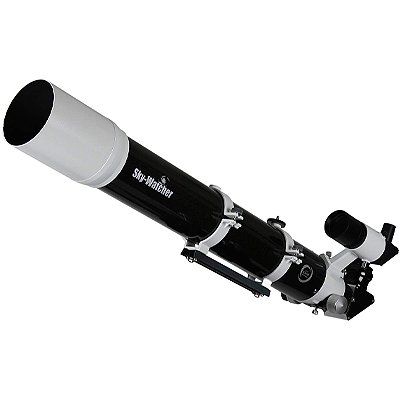
If you’re at least an intermediate astronomer looking for a telescope that’s excellent at what it does (and doesn’t require selling a kidney to buy it), we recommend the Sky-Watcher ProED 100mm.
It’s the absolute best bang for your buck.
In comparison with other telescopes in its price range, its optics are unbeatable.
Though its 100mm aperture is 20mm below the “sweet spot,” it still excels at viewing DSOs with clarity.
It also works exceptionally well for astrophotography and the magnification can be pushed up to 50% higher than the manual recommends.
A few downsides of this telescope include no mount, a reportedly flimsy carrying case, and eyepieces that are good quality but not the greatest (which you can always replace).
What We Liked
- Great for astrophotography
- Excellent magnification capabilities
- Surprisingly lightweight
- Apochromatic: reduces chromatic aberration!
What Can Be Improved
- No included mount
- Mediocre quality carrying case
Aperture: 100mm
Focal Ratio: f/9
Weight: 29 lb
11. Meade Infinity 102mm Altazimuth Refractor Telescope
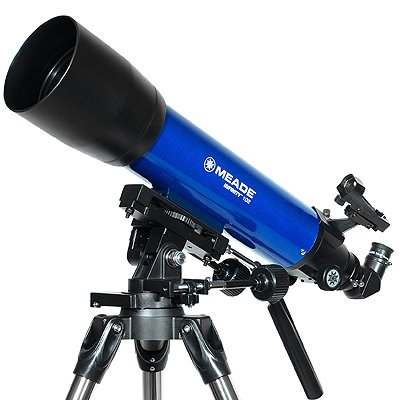
The Meade Infinity 4” refractor telescope is ideal for the whole family.
It offers great views of the night skies, moon, planets, star clusters, and is perfect for land viewing.
My wife loves ships and we were able to see fabulous detail of cruise ships passing on the horizon.
For beginner stargazers, this is a cheap refractor telescope that offers great quality.
It features a 102mm (4″) lens with a focal length of 600mm. The precision Altazimuth mount has slow-motion controls.
We were able to focus on an object and easily keep it in view as it moved across the sky. Nothing is more frustrating than an object that jumps out of view and takes forever to find again.
The Meade Infinity 102mm comes with 3 eyepieces that give a choice of low, medium, and high-powered magnification. It has a Red Dot Viewfinder that helps to point objects.
The accessory tray stores accessories for easy access while observing. Also included with this refractor telescope is an Autostar Suite Astronomy planetarium DVD with over 10,000 celestial objects.
What We Liked
- Well priced
- 4″ (102mm) aperture for bright views
- 3 eyepieces for low, medium and high magnification
- Great for viewing celestial and terrestrial objects
- Slow motion controls for ease of use
- Easy to move around
- Autostar Suite Astronomy planetarium DVD
What Can Be Improved
- May be too simple for professionals
- Not motorized
- Could be more stable
Aperture: 4″ (102mm)
Magnification: 21-204x
Focal length: 600mm
Mount type: Altazimuth
Weight: 24 lbs (10.88kg)
Features: Well priced, 3 eyepieces
Best for: Beginners, terrestrial and celestial viewing
12. Orion AstroView 120ST Equatorial Refractor Telescope
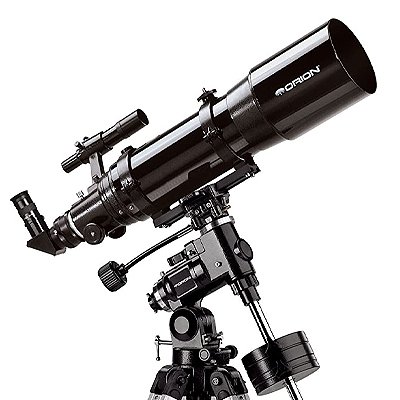
If you are looking for a refracting telescope as a great family hobby, the Orion AstroView 120ST Equatorial Refractor Telescope gives hours of fun and entertainment.
It offers a fabulous option with a wide-field view of deep-sky objects with crisp, clear resolution.
The telescope has a 120mm aperture and 600mm focal length.
Stunning views of nebular clouds, galaxies, and star clusters took our breath away.
Closer to home, we looked at the moon and planets in our Solar System. It stands on a sturdy adjustable-height tripod with an equatorial mount.
Even my younger children were able to operate the refracted telescope using slow-motion celestial tracking and internal polar alignment features.
The tube measures only 26″ long, including the dew shield, so it is easy to transport and take along on an outing. We also tried our hand at wide-field astrophotography and were very pleased with the results.
Included in the kit are two Sirius Plossl 1.25″ eyepieces, a 25mm and a 10mm, a 6×30 finder scope, a smooth 2″ rack and pinion focuser, and a 90-degree mirror star diagonal. For added fun with these short tube refractor telescopes, you also get Starry Night astronomy software.
What We Liked
- 4.7″ (120mm) aperture for bright views
- 2 Sirius Plossl 1.25″ eyepieces, a 25mm and a 10mm
- Short tube refractor, easy to set up and use
- Multi-coated optics
- Sturdy adjustable Equatorial mount
- Slow-motion controls
- Great for astrophotography
What Can Be Improved
- Higher price
- Not motorized
- Heavy for transporting
Aperture: 4.7″ (120mm)
Magnification: 24-60x
Focal length: 600mm
Mount type: Equatorial mount
Weight: 36.3 lbs (16,5 kg)
Features: Short tube, dew shield, 2 eyepieces
Best for: Intermediate stargazer, bright deep sky objects
Also read:
- 5 Best Computerized Telescopes in 2020 [GoTo & Non-Motorized]
- 5 Best Kids Telescopes in 2020 [to Discover Astronomy]
- 5 Best Solar Telescopes in 2020 [to Observe The Sun]
- 5 Best Dobsonian Telescopes in 2020 [From 8 to 12-inch Options]
Refractor vs. Reflector Telescopes
There are two primary types of telescopes: refractors and reflectors. A refractor telescope uses a large lens in the font, known as the “objective,” and an eyepiece in the back. Both pieces work together to focus light and present a clear image of the universe to an observer.
Refractors
In general, refractor telescopes are better suited for observing planets—they’re often used by astrophotographers to capture images of the Moon, Mars, and Saturn.
- However, a regular refractor telescope suffers from what is known as chromatic aberration, which causes objects to have a halo-like effect surrounding them.
- Many refractor telescopes are apochromatic these days, which accounts for this issue and corrects it.
- Refractors are typically more expensive than reflectors, as the glass used is more sophisticated, though they require little maintenance.
Reflectors
Reflector telescopes use a combination of mirrors at the front to focus and reflect light down to the eyepiece.
- Reflectors generally provide much larger apertures, which means they can gather more light and display crisper and brighter images.
- Reflectors are best at observing large deep-sky objects, such as Messier objects, nebulae, and galaxies.
- They do require more maintenance than refractors—the optics (mirrors) have to be cleaned regularly and realigned.
All-in-all, neither type is necessarily better than the other—they’re both suitable for different purposes. One is only better than the other, depending on what you’re trying to view!
Refractor Telescope Price Timeline
Since refractors use a hardy piece of glass, which is crafted specifically for use in a telescope, they can be a bit pricey. You’ll have to pay at least $200-$300 for a quality budget-friendly refractor, and upwards of $1,500+ for some of the fancier models.
We’ve broken down the prices below into five categories: bargain, budget, mid-range, upper mid-range, and high-end. Each category describes the price ranges of refractors and what kind of quality you can expect to get depending on your budget (keep in mind these are price ranges for the telescope themselves, some don’t come with a tripod mount or any external accessories). The most important thing about a telescope is its aperture, so each range mentions what aperture to expect.
Bargain: $50-$150
Similar to buying a musical instrument, telescopes under the price of $150 use cheap parts—the optical components in telescopes are expensive to produce correctly! These telescopes are acceptable if you’re only going to use it once or twice, or if you have a child interested in astronomy but don’t have a lot of cash to spare. However, dropping an extra hundred or so is still worth it in the long run.
Budget: $150-$400
Budget refractors will come with fewer features and less capability but are still suitable for planetary viewing and general stargazing. They’re best for beginner astronomers or those on a budget. Expect an aperture between 90mm and 102mm in this price range, with some exceptions pushing a few millimeters higher or lower.
Mid-range: $400-$600
With mid-range refractors, observers will be able to view star clusters and galaxies more clearly with better contrast. These models typically begin to include an apochromatic feature, which negates the chromatic aberration effect that plagues cheaper versions. You can expect an aperture range of around 127mm or less in this range.
Upper mid-range: $600-$1000
Upper to mid-range telescopes dwell in the $600+ range. At this price range, apertures generally remain the same, though focal lengths change to provide better and crisper views. Apertures for this range typically fall between 120 and 200 mm. Most products in this range provide better eyepiece focusers, which are capable of magnifying the image between 50x to 200x of its normal quality.
High-end: $1,000+
High-end telescopes are distinctly different in two ways, the size of the aperture and focal length. The weight of the telescope typically correlates with the viewing capability, so the heavier the telescope, the better it will be (this also determines the price, which can rise exponentially as the aperture grows). These telescopes are for hardcore astronomers who intend to dedicate serious time to gazing at the universe.
What Are You Going to Observe?
The most critical question to ask yourself when choosing a telescope is, “what do I want to observe with it?” There are hundreds of different models with a variety of various features to choose from, each catering to different needs and expectations. What you’ll need depends on what you’re looking to observe!
Deep-Space Objects (DSOs)
Deep-Space Objects – Reflector telescopes tend to work better for deep-space objects because they have higher apertures and don’t suffer from any chromatic aberration. However, upper mid-range or high-end refractors are mostly apochromatic now, meaning they account for the halo effect caused by chromatic aberration, so either will work!
Planets and Moons
Planets & Moons – Refractors generally work the best for viewing planetary bodies. Refractors are more compact than reflectors, making them much easier to lug around to different locations. Moving around to different areas is often an essential aspect of planetary viewing, as you’ll need a suitable low light-pollution location to get the most unobstructed views.
Astrophotography
Astrophotography is a rather general term, so both types of telescopes can work depending on what you’ll be photographing. Though, in general, refractors offer the most versatility (sharper images) needed for astrophotography. They’re also more comfortable to carry around, and most importantly, they don’t need regular adjustment or maintenance.
How to Choose the Right Refractor Telescope?
Choosing a refractor telescope that best suits your needs mostly boils down to two specifications: aperture and focal ratio.
The aperture determines the distance and clarity of your viewing experience, while the focal ratio determines just how narrow or broad the universe will appear in your telescope.
There are additional things that matter, such as the quality of your focuser, eyepiece, accessories, and mount, but these remain the most critical aspects of every telescope.
Aperture
Aperture is the most crucial metric for all telescopes, as it’s the diameter of the primary lens or mirror.
- The farther an object is, the higher the aperture you’ll need to observe it. If you’re looking to observe deep-sky objects in crisp quality, you’ll want an aperture of around 140mm.
- However, you can view most objects in good quality with apertures between 80mm and 120mm, with 120mm generally being regarded as the “sweet spot” for most amateur astronomers.
- The higher the aperture, the better the view (though after 200-300mm, the price and weight of the telescope tend to rise exponentially).
Focal Ratio
The focal ratio is determined by dividing the focal length, which is simply the distance light has to travel from the front of the telescope to the back, by the diameter of the front lens or mirror, known as the objective (denoted as F/D, where F is the focal length and D is the aperture).
- It also determines, to some extent, its physical length. In general, if you’re looking to observe single objects, such as planets or stars, you’ll want a longer focal ratio of f/10 or higher.
- If you’re looking to observe more massive objects, such as viewing star clusters or galaxies, you’ll need a lower focal ratio for a broader view, typically f/7 or less.
Magnification
Magnification is simply how much larger the image you are viewing is, compared to seeing it with the naked eye. Depending on the telescope, magnification values will vary from around 10x up to around 300x.
- To calculate the magnification, we take the focal length of the telescope and divide it by the eyepiece focal length.
- Magnification = Telescope focal length ÷ Eyepiece focal length.
- For example, if your telescope has a 1000mm focal length and you are using a 25mm eyepiece, the magnification would be 1000mm ÷ 25 = 40
Another useful calculation for those who are not too technical is to use the aperture size in inches and multiply it by 50. For example, a 6 inch scope can magnify up to 300x, while an 8 inch refractor telescope can magnify up to 400x. This is a rough calc. In reality, when you buy a quality telescope, you will get all the details of each eyepiece and its magnification.
For a beginner, a good quality scope will offer a magnification of 20x-60x, which is ideal for crisp, razor-sharp images. The higher the magnification, the more detail you will see. If your magnification becomes too large, you may start to get distorted images.
You will see that many of the telescopes we reviewed come with 2 different eyepieces. For example, a 10mm and a 20mm. This allows you to choose different magnifications for viewing on the same scope. For example, to see the whole moon, you could choose a magnification of around 50x. To see the details of craters, you would need to go up to 150x.
Telescope Mount Types
There are a number of different mounts for different types of refractive telescopes that you will need to consider. When buying a scope, it usually comes with a mount, making things simpler for you. If there is no mount, you will have to decide what is best for you and what suits the scope you have bought.
Basic Fixed Tripod
A very basic tripod will support your telescope. It does, however, offer the tricky challenge of tracking and keeping the object you want to view in your eyepiece. These tripods are also lightweight and may result in your scope toppling over.
Equatorial Mount
These mounts are commonly found on best refractor beginner to intermediate ranges of telescopes. They feature one rotational axis parallel to the Earth’s axis of rotation. You can track an object by moving the telescope in one direction only, up and down. This type of mount is great for an enthusiastic beginner who doesn’t have a huge budget.
German Equatorial Mount
The German Equatorial mount has a distinctive large counterweight extending on the opposite side from the telescope. This counterweight offers balance, making the telescope refractor set up more stable.
Altazimuth Mount
With an Altazimuth Mount, you are able to move your telescope in two directions. The first is in an east-to-west direction (azimuth), the second is an up-or-down (altitude) movement. Altazimuth Mounts usually have slow-motion controls that allow you to easily keep focus on a celestial object as it moves across the sky.
GoTo Mount
These are more advanced mounts that are computerized and do the work for you. By setting your scope onto a particular celestial object, the motorized mount will keep the eyepiece positioned on the object and track it as it moves across the sky. A motor with computer control drives both axes of the mount.
Eyepieces
Eyepieces of refractive telescopes fit over the aperture and allow you to view your terrestrial or celestial object. Different sizes of eyepieces offer different levels of magnification.
To calculate the magnification of an eyepiece, we take the focal length of the telescope and divide it by the eyepiece focal length.
Magnification = Telescope focal length ÷ Eyepiece focal length.
For example, if your telescope has a 1000mm focal length and you are using a 25mm eyepiece, the magnification would be 1000mm ÷ 25 = 40.
What may be confusing is that a smaller number on an eyepiece gives a higher magnification. So a 40mm focal length eyepiece is a low power eyepiece. A 32mm focal length eyepiece is a medium power eyepiece and a 6.3mm focal length eyepiece offers the highest magnification on a large refractor telescope.
To see the nebula clusters with refractors, a 40mm eyepiece is perfect. To see the surface of the moon, planets, and star clusters, a 32mm eyepiece will do the job. For far-away objects and very detailed views, a 10mm eyepiece is best.
Well-known top-quality refractor eyepieces are Sirius Plossl, Celestron, Orion, Baader, and SVBONY. Your telescope will come with eyepieces. As you become more experienced, you can purchase additional ones for your needs.
FAQ
What is the best refractor telescope for beginners?
For beginners wanting a refracting telescope, we recommend the Meade Infinity 102mm Altazimuth Refractor Telescope. It is well-priced and offers great views of the night skies, moon, and planets. It has a 4” aperture and comes with 3 eyepieces for low, medium, and high magnification.
What is the best refractor telescope for astrophotography?
The Orion AstroView 120ST Equatorial Refractor Telescope is a best refractor telescope for astrophotography. It offers a wide-field view of deep-sky objects with crisp, clear resolution. The Equatorial mount is sturdy and is easily adjusted for smaller children.
Who makes the best refractor telescope?
When looking at refractor telescopes for sale, we were most impressed with the Celeston Range of refractor telescopes. They offer a choice from beginners to serious intermediates and also the ability to grow-into your scope. These best refracting telescopes will last you for years to come as your skill-levels increase.
Which is the best refractor or reflector telescope?
In general, refractor telescopes are better suited for observing planets—they’re often used by astrophotographers to capture images of the Moon, Mars, and Saturn.

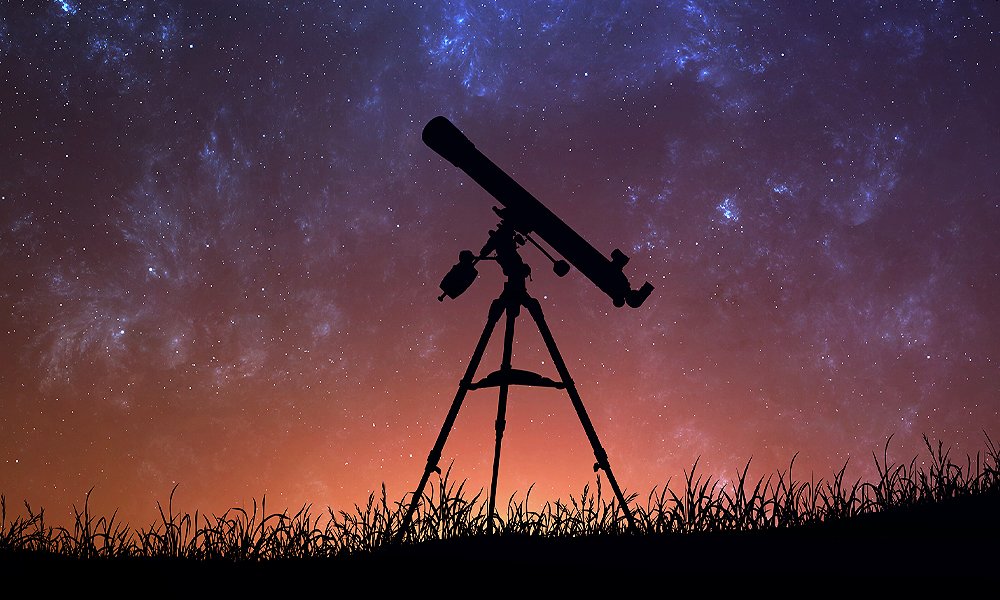

![12 Best Budget Telescopes in 2024 [Maximum Value for Money]](https://www.planetguide.net/wp-content/uploads/2019/12/refreactor-telescope-768x461.jpg)
![12 Best Telescopes for Kids in 2024 [Toddlers to Teens]](https://www.planetguide.net/wp-content/uploads/2019/12/Depositphotos_2254021_l-2015-768x512.jpg)

